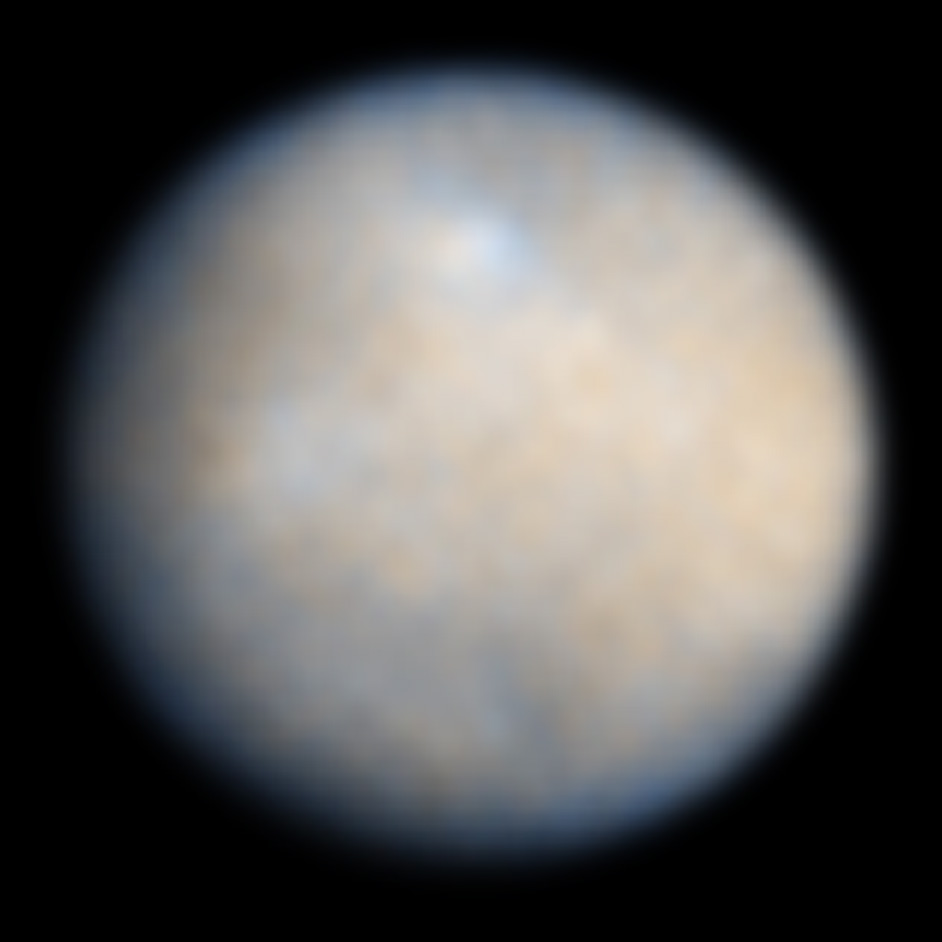
The other anniversary that the 1st of January brings to mind is that on this night in 1801, Piazzi discovered Ceres (named after the goddess of agriculture; symbol: the sickle ), hailed then as the fifth planet, located between Mars and Jupiter, as 'predicted' by Bode's Law.
), hailed then as the fifth planet, located between Mars and Jupiter, as 'predicted' by Bode's Law.
Its size, however, shewing only as a starlike point of light (hence 'asteroid', a term Herschel coined) seemed much less than that of the other known planets. Within a few years several other such bodies (Juno, Pallas, Vesta,, etc.) were found, and after several decades more were found, then more, then even more... by the 1850's, Ceres was demoted from planet to asteroid. It is now known to be about 975 km across, containing 30% of the total mass of the asteroid belt, composed of at least 100,000 'small solar system bodies'. It is much smaller than the Moon.
Come 1930, Pluto was found - observe the parallels with Ceres - being acclaimed as the "Planet X" long-sought, whose gravitational influence would explain divergences in the orbits of Uranus and Neptune. But yet again, it shewed a scarce-resolvable disc even in the largest telescopes, and its estimated size and mass kept on being revised downwards. How could it sway the orbits of the ice giants? Seemingly so different to the others, could it be a planet? A waggish scientific paper of the 1970's, graphing these estimates, predicted tongue-in-cheek that soon it would vanish entirely... Remeasurement of the masses of Uranus and Neptune made postulation of a large outer planet influencing them unnecessary. In 1992 the first of many similar objects to Pluto was found, shewing Pluto to be only the so-far foremost member of the long-predicted Kuiper Belt, and the discovery of Eris in 2005 - larger than Pluto - sealed its fate. Pluto was demoted to 'dwarf planet', a category to be shared by Eris at least - and Ceres.
The misfortune of Pluto was the good fortune of Ceres! It is now accounted a 'dwarf planet', large enough to be spherical, indeed thought to have undergone internal differentiation and formed as a protoplanet, but which (like Pluto and Eris) never accreted sufficient other material to sweep clear its orbital zone of influence (in Ceres' case, the asteroid belt), as did the eight true planets of the Solar System.
By a final coincidence, Ceres will be visited, God willing, by a US space-probe (Dawn) in February 2015 (en route since September 2007, using the new ion-drive), only a few months before the US space-probe New Horizons approaches Pluto in July 2015 after its great voyage of 4½ billion km (launched January 2006).
Just as I am looking forward to the upcoming 14th of January flyby of Mercury by MESSENGER, imaging as yet unseen parts of that planet, so I anticipate what will be seen at Ceres and Pluto in seven years' time.
The great thing about astronomy is that it lifts up the mind to wonder at the universe. Cæli enarrant gloriam Dei, et opera manuum ejus annuntiat firmamentum. (Ps 18:1) Quoniam videbo cælos tuos, opera digitorum tuorum, lunam et stellas, quæ tu fundasti, quid est homo, quod memor es ejus? (Ps 8:4-5a)








No comments:
Post a Comment